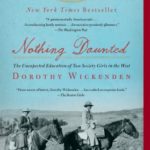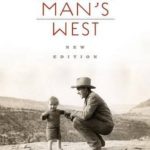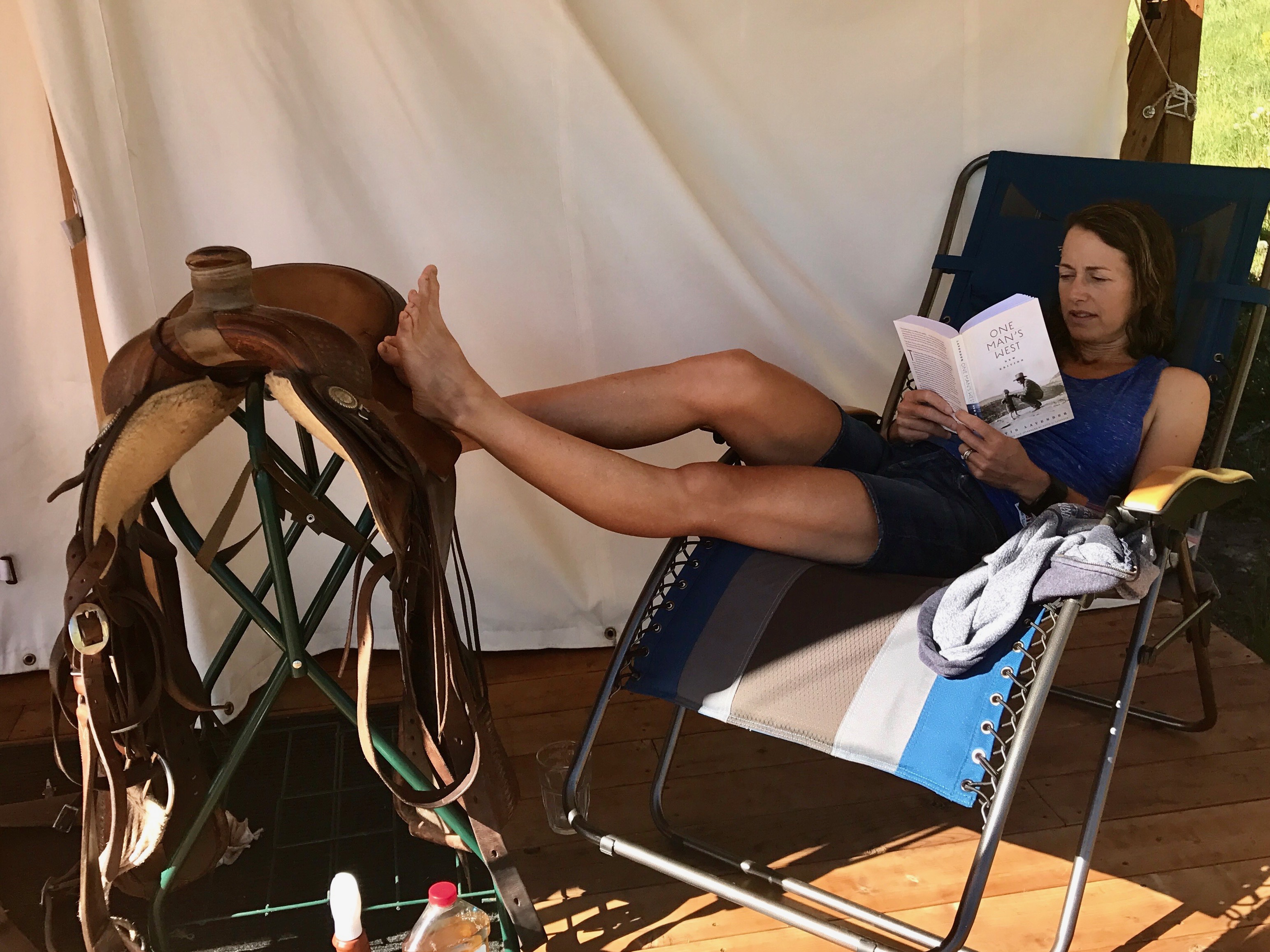Over the past several months, while in Colorado, I became a reader again. I made time in the mornings and late afternoons to read for 20 or so minutes, because whenever I save reading for nighttime, then I fall asleep after a mere four pages. It felt so good to activate my imagination again this way, and to extend my attention span past article length or web-based skimming. Oddly, and thankfully, this reading seemed to expand rather than siphon off the day’s time.
I made a point of reading about the West to deepen my understanding of Colorado, California and states in between—their history, culture, politics and myriad pressures such as population growth and climate change. I know, that sounds awfully serious, so rest assured that the books below are good reads.
Before I introduce these five books, please consider ordering my book, The Trail Runner’s Companion, for yourself or as a gift to any runner/hiker who seeks better experiences while traversing wilderness trails and healthier, happier running in general. A recent review called it, “a compelling guide to how to improve your trail and ultra running performance … From training tips to nutrition to backcountry safety, Lavender Smith couples her own experiences with science to create a telling story of how to improve your skills. … She is one of us, a trail runner who loves the mountains and the desert, and a person seeking to push herself further.” If you already purchased the book, you could do me a big favor by writing a short customer review on its amazon page here, which will help the book show up in search results. Thank you!
Disclaimer: The links to books below go to Amazon, and I get a small commission through their affiliate program for click-throughs. You can support independent bookstores by buying through Indiebound.org or your local bookstore instead.
The Blue Hour by Laura Pritchett (Counterpoint, 2017)
by Laura Pritchett (Counterpoint, 2017)
 In Laura Pritchett’s novel set in a fictional small mountain town, people go to livestock auctions looking for love, and the local veterinarian and farrier earn extra respect. A woman who works as a housecleaner and sells pot on the side has sex with her boyfriend under an apple tree, where she spots bear scat and saves her neighbor’s kids from a bear. A girl named Dandelion—because her parents made love in a field of them in Montana—grows up with dreams of being a rodeo queen and instead gets trapped in an abusive relationship with a broken bronc rider who cooks up meth. Another girl, named Honey, loses her father to terminal illness, and the guardian-to-be—the horse shoer who says he wishes there were a book called How to Have Unfucked-Up Relationships—is terrified about raising a girl on his own.
In Laura Pritchett’s novel set in a fictional small mountain town, people go to livestock auctions looking for love, and the local veterinarian and farrier earn extra respect. A woman who works as a housecleaner and sells pot on the side has sex with her boyfriend under an apple tree, where she spots bear scat and saves her neighbor’s kids from a bear. A girl named Dandelion—because her parents made love in a field of them in Montana—grows up with dreams of being a rodeo queen and instead gets trapped in an abusive relationship with a broken bronc rider who cooks up meth. Another girl, named Honey, loses her father to terminal illness, and the guardian-to-be—the horse shoer who says he wishes there were a book called How to Have Unfucked-Up Relationships—is terrified about raising a girl on his own.
Each chapter introduces a different narrator and presents a study of one of these earthy characters, all of whom are linked by the town and also, by a suicide by one of the locals who struggled with mental illness. I loved the portrayal of a community whose denizens are unpretentious and passionate—finding love, raising kids and getting by in cabins and mobile homes. They work with their hands and care for their neighbors, and the seasons and strong weather shape their lives.
I met Laura Pritchett and attended a writing workshop she hosted during the summer in Telluride. Her ability to paint a scene that evokes all senses, and to write in a character’s voice in a way that sounds utterly convincing and original, wowed and inspired me.
West of 98: Living and Writing the New American West (edited by Lynn Stegner and Russell Rowland, University of Texas Press, 2011)
(edited by Lynn Stegner and Russell Rowland, University of Texas Press, 2011)
 I heard about this collection of essays on Colorado Public Radio while driving solo across the Navajo reservation in the Four Corners area. I had been contemplating the vastness, dryness and beauty of the Southwest desert, along with the tragedy, history and economics that shaped the populations of Native Americans and non-native lower-income residents out there. I also was thinking about how drastically the land and the communities change from desert to mountain regions, although homogenization from chain stores, fast food and Amazon gives a certain sameness to towns even way out here. My mom’s city of Montrose—one of the few affordable, mid-sized cities in the southwest corner of Colorado—seems as if it could be anywhere because of its Target and Walmart, which therefore gives me a soft spot for its branch of the uniquely Western chain store Murdoch’s, a ranch supply outfit that we frequent for stuff for our horse and landscaping. You know you’re not in the Bay Area anymore when you walk past refrigerator-sized gun cases, a clothing department dominated by Wrangler and Carhartt, and all the herbicide you need to control the dreaded purple-headed thistle.
I heard about this collection of essays on Colorado Public Radio while driving solo across the Navajo reservation in the Four Corners area. I had been contemplating the vastness, dryness and beauty of the Southwest desert, along with the tragedy, history and economics that shaped the populations of Native Americans and non-native lower-income residents out there. I also was thinking about how drastically the land and the communities change from desert to mountain regions, although homogenization from chain stores, fast food and Amazon gives a certain sameness to towns even way out here. My mom’s city of Montrose—one of the few affordable, mid-sized cities in the southwest corner of Colorado—seems as if it could be anywhere because of its Target and Walmart, which therefore gives me a soft spot for its branch of the uniquely Western chain store Murdoch’s, a ranch supply outfit that we frequent for stuff for our horse and landscaping. You know you’re not in the Bay Area anymore when you walk past refrigerator-sized gun cases, a clothing department dominated by Wrangler and Carhartt, and all the herbicide you need to control the dreaded purple-headed thistle.
Thus the timing was right—when I was feeling melancholy about all the modern forces crowding and taming the West—to hear about this book. If memory serves correctly, the radio interview featured the editor, Russell Rowland, who was myth-busting the persistent stereotypes related to cowboys and mountain men as he articulated the complexity of the West and our collective, complicated relationship with it.
The book features short essays from a who’s-who of noted Western writers and historians. I’ve only read about a dozen of the essays from the 67 featured writers, but each held my attention and got me to think about what it means to be a westerner, and how we view and care for (or neglect or exploit) its landscape. Dive into this collection, and you’ll find myriad engaging stories of coming of age, hardship, migration and mortality.
“With a remarkable capacity to trigger rapid-onset nostalgia, the West has for decades echoed with laments over its decline and impending disappearance,” writes contributor and Colorado State Historian Patricia Nelson Limerick, in her essay “The Fatal West.” “… Before-and-after contrasts are regularly accompanied by a deep sigh of regret.” I am one of those who sigh deeply upon contemplating the changes, but her story—along with the others—helped me take a broader, less romantic, more informed view of past and present.
Old Fences, New Neighbors by Peter R. Decker (Fulcrum, 2006)
by Peter R. Decker (Fulcrum, 2006)
 Anyone who feels drawn to the region around Ouray County—the gorgeous, remote area that includes box canyons and peaks on the Hardrock 100 course—should read this book for a greater appreciation of the region’s history and its uncertain future. Make that, anyone who feels drawn to soulful small mining and ranching towns in the West should read this book.
Anyone who feels drawn to the region around Ouray County—the gorgeous, remote area that includes box canyons and peaks on the Hardrock 100 course—should read this book for a greater appreciation of the region’s history and its uncertain future. Make that, anyone who feels drawn to soulful small mining and ranching towns in the West should read this book.
I have ultrarunner Gary Gellin to thank for giving me a signed copy. When Gary visited our land near Telluride, to pitch a tent during his running and biking tour of Colorado, he said repeatedly, “You’ve got to read this book.” Perhaps he recognized—as did I, as I turned the pages—that I straddle the generations and lifestyles that Peter Decker compelling captures in his book about the changes that hit Ouray County and places like it in the latter part of the 20th century.
“Beginning in the 1980s, Ouray County experienced a demographic and cultural invasion that radically transformed and disrupted the place and its residents. The outsiders brought with them values, lifestyles, and personal expectations never imagined, much less experienced, by the sons and daughters of the pioneers who settled the region a century earlier. When swimming pools, European sports cars, llamas, and ‘ranchers’ clad in jogging outfits began to appear on nearby ranches, I knew the New West had arrived in the valley,” writes Decker, a history professor and Vietnam war correspondent who began ranching several hundred acres in Ridgeway in the early 1970s. A neighbor told him early on that his PhD was fine, “but in this country, son, it darn well better mean posthole digger.”
On the one hand, I have family ties to the “old Colorado” he portrays so well in his chapters on homesteading and early-20th-century ranching, because my grandfather and his stepfather worked in mining and ranching in this region. In fact, our family briefly owned the Ridgeway restaurant, The Little Chef, that formed some of Decker’s first impressions of cowboys and chicken fried steak when he arrived in the early 1970s. I can recall my dad, in the 1980s and ’90s, bemoaning those whom he called “the beautiful people”—aka Hollywood types—changing the culture and cost of living in Telluride.
On the other hand, my husband and I represent the new generation that Decker eyes warily; that is, we’re Californians who make money not from the land but from business in a cosmopolitan area disconnected from southwestern Colorado, and we bought one of the 35-acre “ranchettes” that Decker derides as breaking up ranch land for the benefit of monied folks seeking a mountain lifestyle. The book really made me ponder how owners of undeveloped acreage like us can help, not hurt, the region’s sustainability.
Decker gives some credit to wealthy Texans and Californians for helping to preserve open space: “It is ironic that urban money has preserved the rural countryside and its traditional way of life. Not too long ago, before the rural West became a haven (if not an escape) from the horrors of the American city, ranching provided the economic rationale for an open landscape. Now it is the urban resident—the dreaded city slicker—who can best afford to save and preserve the western countryside from the forces that have trashed the suburban landscape.”
But he also notes, “When local ranchers look at a hobby ranch with its fancy equipment and cattle, all purchased with money earned elsewhere, they are reminded that it is now impossible for their sons and daughters to buy a place of their own … What I personally find most troubling about the new ranchers is not the way they gained their wealth, or their radically different lifestyles, but the historical disconnection between them and the county’s older residents. The newer residents have little knowledge or appreciation of the history that produced the skills and survival traits carried forward by three generations of local citizens.”
Thanks to this book, my husband (who also read it) and I feel less historically disconnected. When we walk our irrigation ditch that was dug in the 19th century, or when we awake to the sounds of sheep because a sheep herder is driving them across our parcel to graze, we can better understand the traditions and economics behind it, and how the collaborative, hands-on work ethic that made networks of ditches, miles of fences and friends of neighbors throughout the 20th century is something we should strive to carry on.

Morgan inspecting and maintaining our ditch.

Me saying good morning to the sheep who show up periodically to graze on our land.
Nothing Daunted: The Unexpected Education of Two Society Girls in the West by Dorothy Wickenden (Scribner, 2011)
by Dorothy Wickenden (Scribner, 2011)
 Two college-educated young women ditch high society in New York and head west to Colorado in 1916 to teach the penniless, isolated children of homesteaders, and their one-room school house becomes a refuge and community hub in the wilds of northwestern Colorado. This is the true epistolary story of Dorothy Woodruff and Rosamond Underwood, told by Dorothy’s granddaughter, The New Yorker executive editor Dorothy Wickenden, who discovered bundles of her grandmother’s letters from that year when the women embarked on their adventure.
Two college-educated young women ditch high society in New York and head west to Colorado in 1916 to teach the penniless, isolated children of homesteaders, and their one-room school house becomes a refuge and community hub in the wilds of northwestern Colorado. This is the true epistolary story of Dorothy Woodruff and Rosamond Underwood, told by Dorothy’s granddaughter, The New Yorker executive editor Dorothy Wickenden, who discovered bundles of her grandmother’s letters from that year when the women embarked on their adventure.
They traveled to the small town of Hayden, 25 miles west of Steamboat Springs and a world away from the sophistication of Denver. With virtually no prior outdoors experience, Dorothy and Rosamond had to learn to ride, to get to work during blizzards, to manage the numerous romantic overtures from single men who dominated the outpost, and of course, how to teach a ragtag group of mostly illiterate children of varying ages.
Wickenden writes of her grandmother in the introduction, “She and Ros, like other easterners going west, were time travelers, moving back to the frontier. Although they ventured out after the first settlers, and went by train rather than covered wagon, their destination felt more like 1870 than 1916. They took with them progressive ideas about education, technology, and women—and postcards from their travels abroad. The homesteaders—motley transplants from across the country, Europe, and Russia—lived almost twenty miles north of Hayden. Effectively cut off from modern life by poverty and the Rocky Mountains, the pioneers found the two women as exotic as Dorothy and Ros found them.”
Beyond enjoying this real-life historical tale, I appreciated the portrayal of the mountains and forests not far from Steamboat Springs, where I got to visit and run in September. If you like this book, then you’ll also probably like Tomboy Brideby Harriet Fish Backus, a memoir about a young woman with Victorian sensibilities adapting to life with her new husband, at the turn of the century, in the rugged, high-altitude Tomboy Mine above Telluride.
One Man’s West by David S. Lavender (Bison, 1943; new edition 2007)
by David S. Lavender (Bison, 1943; new edition 2007)
 I saved my favorite for last. This summer, I re-read my grandfather David S. Lavender’s memoir about the period of his life, during the early 1930s, when he worked at the Camp Bird Mine in Ouray and as a cowboy on a family cattle ranch. The book has been in print continually since its publication in 1943 and is perhaps his most popular, which is saying a lot considering that he wrote some 40 nonfiction and fiction books, two of which earned Pulitzer nominations.
I saved my favorite for last. This summer, I re-read my grandfather David S. Lavender’s memoir about the period of his life, during the early 1930s, when he worked at the Camp Bird Mine in Ouray and as a cowboy on a family cattle ranch. The book has been in print continually since its publication in 1943 and is perhaps his most popular, which is saying a lot considering that he wrote some 40 nonfiction and fiction books, two of which earned Pulitzer nominations.
Read this book if you want to know what it was like to live in a hardscrabble boardinghouse above timberline with recent immigrants, and to spend all day burrowing through busted-up rock deep inside the San Juan Mountains; or if you want to feel what it’s like to sit in a saddle and drive cattle across a range and to manage around-the-clock work with ornery animals and cattlemen. (If you get a copy of the book, please make sure it’s the new edition from 2007, as it includes an introduction and afterword by my dad to put my grandfather’s life and times in better context; a collection of photos; and a poignant, perfect eulogy that my brother wrote when my grandfather died in 2003.)
This isn’t just my grandfather’s story; it’s a vivid portrayal of the whole region’s lifestyle and economy on the cusp of the Depression, before it irreversibly changed with modernization after the onset of World War II and the proliferation of automobiles.
If you read my recent post about my grandfather and his brother Dwight—who was a widely respected mountaineer in that era—then you know a bit about their mountain skills and exploits. “High-Altitude Athletics” is one of my favorite chapters in One Man’s West, describing the methods and courage of the San Juan Mountaineers in the late 1920s and early ’30s as they explored and ascended peaks.
In one passage, my grandfather accompanies a group to tackle the 14,250-foot Mount Wilson (an outing that involved more hiking than true climbing), and they encounter a series of challenges that would be familiar to any Hardrock 100 runner who has suffered on slopes of the San Juans. I’ll include some excerpts here because it reads like an epic race report from a mountain ultra:
At lower elevations we encountered mazes of timber falls and impenetrable thickets of underbrush. We struggled through what seemed miles of scree and talus, steep slopes of shattered slide rock that have fallen from the cliffs and roll backward under you with every step you take. Rain drenched us, and as we climbed higher we were presented with the odd spectacle of snow going straight up instead of down. This phenomenon was occasioned by the wind whipping through the basin below …
The storm kept building up intense fields of electricity. When the load reached maturity in the womb of the cloud, a thunderbolt was born. It ripped earthward along whatever projection offered the shortest route. A man standing on that bald ridge would serve very well as a cosmic obstetrician—once. He would never live to do it again.
The scene goes on to describe the group staggering and slipping through the night to get from the summit back down the mountain, one of them succumbing to altitude sickness and needing assistance. They try to set up a camp and bivouac but abandon the idea because “the ground was a sea of mud, and the smoky, stuttering fire we managed to kindle was inadequate to cope with the mass miseries of nineteen exhausted souls.” At last, some 24 hours later, they make it back to the trailhead feeling “ravenous and creaking in every joint.”
When someone asks my grandfather the next morning, “Well, did you like it?” his reply brilliantly captures the mindset of modern-day ultrarunners who suffer mightily in the midst of an event and vow never to do it again—only to describe it enthusiastically the following day and to sign up for another ultra not long afterwards. He writes:
I considered. Fortunately God gave man poor memory for physical discomfort. The active ingredients which made the hurt so brutal at the moment lose their keen edge in retrospect; we are able to look back on them with certain detachment and even make them subject matter of our dearest conversation pieces. Pleasure is different. Memory fondles it. It becomes a nostalgia, poignant and real and difficult to put into words. And so I remembered Mount Wilson. Not the cold and cruel fatigue, but rather the multitude of tiny things which in their sum make up the elemental poetry of rock and ice and snow. The feel of granite under your fingers, the obedient flex of your muscles swinging you upward to the stance you must reach or fail, the taste of a cigarette when you hunker for a moment under a shelving rock. A flash of sunlight, a laugh, an incongruous patch of dwarf flowers at the base of an icy boulder.
“Yes,” I said. “I liked it.”

Reading One Man’s West in June.
If you’d like other book recommendations, please check out the box in the righthand column of my blog, “My Bookshelf.” That sidebar includes two more titles on books of the West that I heartily recommend: The Distance Between Us and The Emerald Mile.
If you have a book about the West that you’d recommend, please describe it in the comments below.

No list of books about the West is complete without something by Wallace Stegner! Wolf Willow, The Big Rock Candy Mountain, Angle of Repose, Beyond the Hundredth Meridian.
Thanks, Sarah, for the book recommendations. My dad lived in Hotchkiss and I have family in Montrose. My dad lived and worked in the mountains around Ouray and Telluride, so the books feel very topical to me, especially the one by your dad. I concur about John’s recommendation about Wallace Stegner.